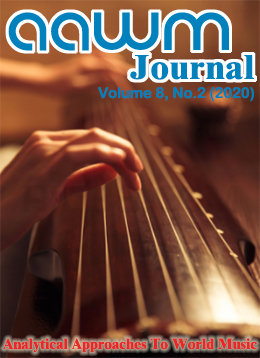 |
|
 |
 |
 |
 |
 |
|
AAWM JOURNAL Volume 8, No. 2 (2020) |
 |
 |
| Volume 8, No. 2 (2020) |
|
 |
 |
| Metrical Structure and Freedom in Qin Music of the Chinese Literati |
| Chun-Yan Tse and Chun-Fung Wong |
|
A general lack of higher-order regularity in temporal organization is one important feature that differentiates qin music of the Chinese literati from most other genres of traditional Chinese music, but this has seldom been discussed in scholarly circles. To fill this gap, the present paper provides a systematic discussion of the freedom in metrical structure characteristic of qin music.
Because rhythmic elements in qin music are not notated in the tablature score, and fine nuances arising from a variety of fingering techniques can affect the perception of phrasing and hierarchies of pulsation, studying the metrical structure of qin pieces is an act of interpretation and depends on a thorough grasp of traditional performance conventions and common melodic patterns in the music. Both authors being experienced qin players, this study is based on our interpretation of music of important qin players of the present and previous generations. Categories of temporal organization without higher-order regularity identified by the authors include "changing meter," "metrically ambiguous," and "free rhythm," as well as the particular category of "pulsation with interpolated half-beats," forming a continuum where each category merges into the next. Our case study of a representative example of the last category demonstrates an accelerating basic pulsation interrupted irregularly by interpolated half-beats. Such a feature has not been well described in traditional non-Western music, and defies the usual binary division of musical time organization in world music studies into categories with or without a basic regular pulse. This interpretation is confirmed by measurement of inter-onset intervals and linear regression analysis. With the irregular interruption, the listener is sometimes not sure whether certain notes are “on a beat” or are syncopated. Together with irregular interruptions to periodicity at higher levels, the metrical structure can be very ambiguous. The performer might have wanted to create an effect of syncopation or hemiola, but was not concerned with maintaining an overall regular pulsation or any higher-order regularity. The freedom in metrical structure in qin music demonstrates the importance of contextual factors in shaping musical characteristics. The distinctive aesthetic and philosophical perspectives of qin players are particularly important in developing this freedom, which we regard as a Daoist conception. The temporal organization in qin music, and in particular, the category "pulsation with interpolated half-beats," should provide useful insights into future work on temporal organization in world music, and indeed toward future work on the typology of temporal organization in music in general.
|
| Uncovering the Music Theory of the Ashkenazi Liturgical Music: “Adonai Malach” as a Case Study |
| Boaz Tarsi |
|
The liturgical music of the Jewish Ashkenazi tradition has remained a practice without a theory for many centuries. For most of its history this tradition has been transmitted orally, and to a significant degree it still is. This liturgical performance is characterized by extemporization or improvisation, but the practitioner’s freedom to improvise has been regulated by what we may reasonably suggest are implicit guidelines that provide a set of parameters for creating this music. Even with the appearance of written music, mainly in the nineteenth century, we find no documentation of how, in addition to the music itself, a convention that governs the semi-improvised aspect of this discipline has been transmitted. The underlying premise of this discussion is that this convention can be conceptualized and articulated by “translating” its implicit guidelines into a model of music theory. Moreover, viewing this discipline in music-theory terms is the key to unpacking it, and to understanding its inner workings. Over the last 150 years some sporadic attempts were made, primarily by insider practitioners, to create such a theory. All of those endeavors incorporated a traditional nineteenth-century concept of “modes” as chiefly scales or modal scales. I argue that a theory befitting the phenomenology of this practice has to adopt a different paradigm that does not necessarily identify scalar structure as the primary defining feature of this system. The new paradigm must also take into account the interconnections among different musical variables as well as integrating a variety of built-in extra-musical factors that govern performance. Above all, the new paradigm must recognize that all of these constituents operate within a variety of degrees of freedom. The primary basic building blocks of this musical tradition, therefore, comprise a more flexible set of constituents—motif-types—that likewise accommodate these degrees of freedom. To illustrate how a new paradigm might better enable us to describe and explicate Ashkenazi liturgical music, I examine one of the traditional “prayer modes,” “Adonai Malach.” The paper does not encompass all of the variables that determine a particular performance that utilizes this mode. Rather, it focuses on motif-types and the degrees of freedom in which they express themselves, their interconnections with textual elements and the structure they create, norms of performance, time factors, and the liturgical calendar.
|
| Global Notation as a Tool for Cross-Cultural and Comparative Music Analysis |
| Andrew Killick |
|
As long ago as 1971 Mantle Hood wrote, in The Ethnomusicologist, of “the chronic problem, transcription of non-Western music, and the chronic solution, ‘doctored’ Western notation.” With the recent resurgence of interest in cross-cultural and comparative music analysis, the “chronic problem” has not gone away, yet efforts to find new and better solutions seem to have dwindled. While dance studies, linguistics, and organology have long benefited from purpose-made written-descriptive systems (Labanotation, the International Phonetic Alphabet, and the Sachs-Hornbostel instrument classification system respectively), world music analysis continues to adopt and adapt the prescriptive notation of one tradition as a descriptive notation for all the others, resulting in distortions and limitations that are generally acknowledged but regarded as inevitable.
This paper proposes an alternative to the “chronic solution” of a kind that was envisaged by Hood as a remote future possibility, and that I argue has now become feasible: a “Laban Solution,” meaning a newly devised notation system designed from the outset to represent any kind of musical sound organization as efficiently as Labanotation can represent bodily movement. I describe a system called “global notation,” under development since 2016 with the aim of providing a consistent and easily learned set of conventions whereby users can specify any information about sound that may be wanted for the purposes of the notation and only that information.
I illustrate how, by making all information optional, global notation offers advantages not only as a descriptive notation but also as an “aesthesic” one—one that can represent what is perceived by listeners as well as what is intended by composers and performers. To demonstrate that global notation should be particularly useful for studies that compare music from more than one tradition, I focus on one such study—Michael Tenzer’s 2011 article “Temporal Transformations in Cross-Cultural Perspective: Augmentation in Baroque, Carnatic and Balinese Music”—and re-notate its examples in global notation, which I suggest might help make insights such as Tenzer’s accessible to a wider readership. I then present some ways in which the Laban Solution of global notation can combine with what Hood called the Seeger and Hipkins Solutions—respectively, mechanical/computerized transcription and knowledge of indigenous notation systems—in working toward the ultimate “Composite Solution” that Hood dreamed of. I conclude by inviting input from interested readers to help develop global notation into a form that will achieve its full potential benefits of accuracy, efficiency, and accessibility.
|
| Responses to: "Global Notation as a Tool for Cross-Cultural and Comparative Music Analysis" |
|
The editors of Analytical Approaches to World Music are pleased to present the following set of invited responses to Andrew Killick’s article “Global Notation as a Tool for Cross-Cultural and Comparative Music Analysis.” While Andrew Killick has been developing global notation since 2016, the present article stems from his presentation at the Fifth International Conference on Analytical Approaches to World Music in Thessaloniki in 2018. The presentation generated lively discussion at the conference, and when Killick subsequently submitted the paper to the journal, one of the peer reviewers recommended publishing responses alongside the article.
In compiling these responses, we have sought to include perspectives from scholars with a range of backgrounds and identities in terms of academic discipline, area of expertise, race, gender, age, and nationality. The set of responses does not fully live up to these goals insofar as the majority of respondents are men, are white, and are based in the US, Canada, or the UK. The fact that most of the women and Black, Asian, and Latinx scholars whom we invited were not able to spare the time to contribute responses may partly reflect the pervasive inequities within and beyond academia that have only been deepened by the ongoing public health crisis. In any case, our failure to attract a more diverse group of respondents should not reflect on the responses themselves, which offer thought-provoking and creative commentaries on the promise and challenges of Killick’s innovation to music notation, and we are grateful to all respondents for their contributions to the project. The responses are linked below in alphabetical order by author’s name.
|
|
|
 |
|
 |
 |
|



